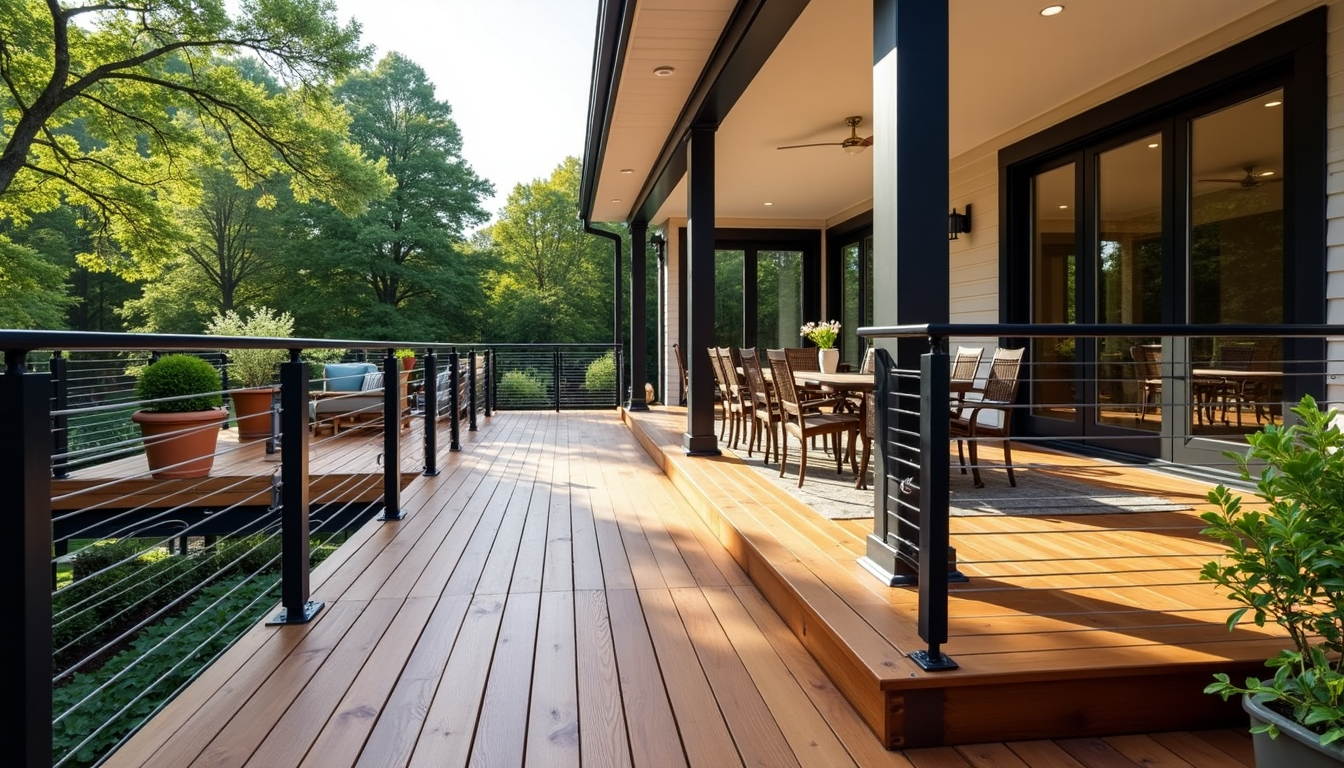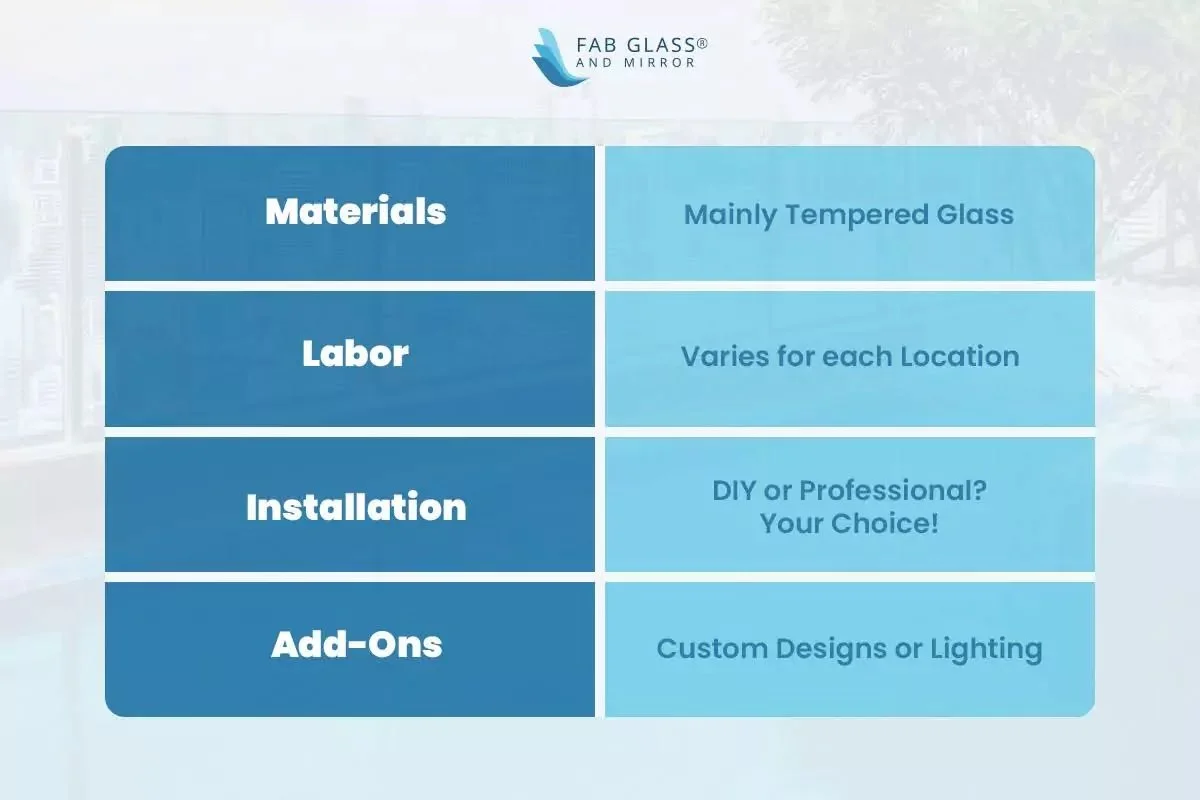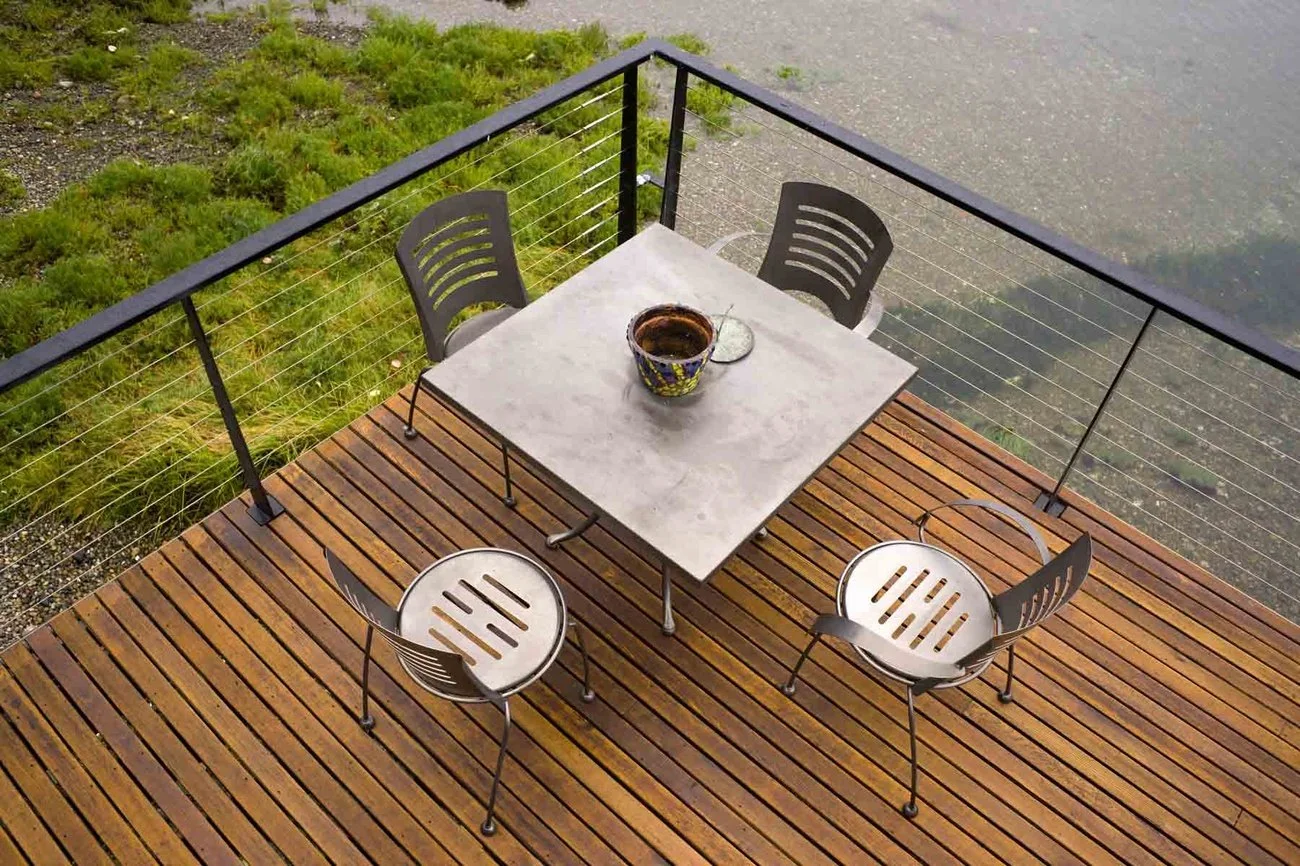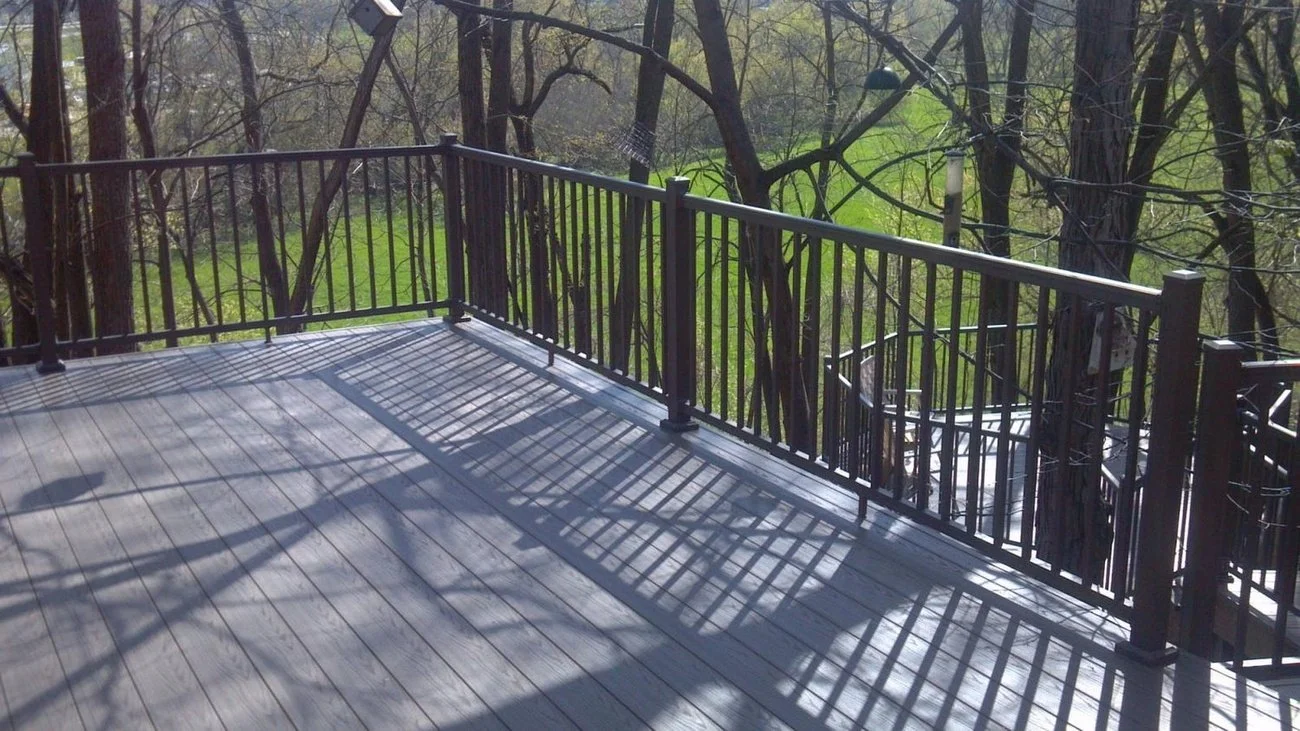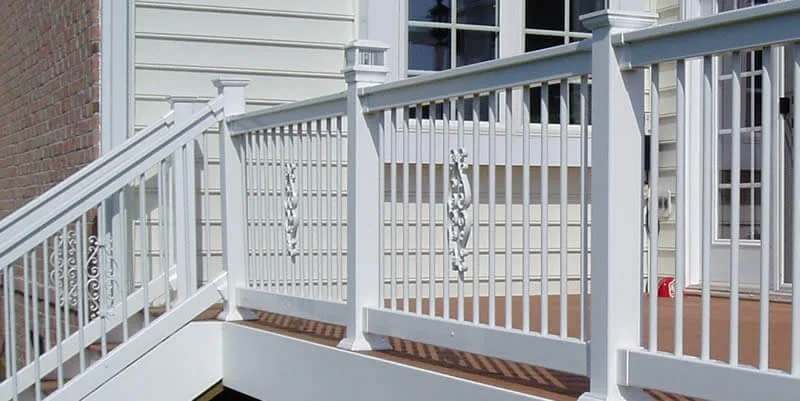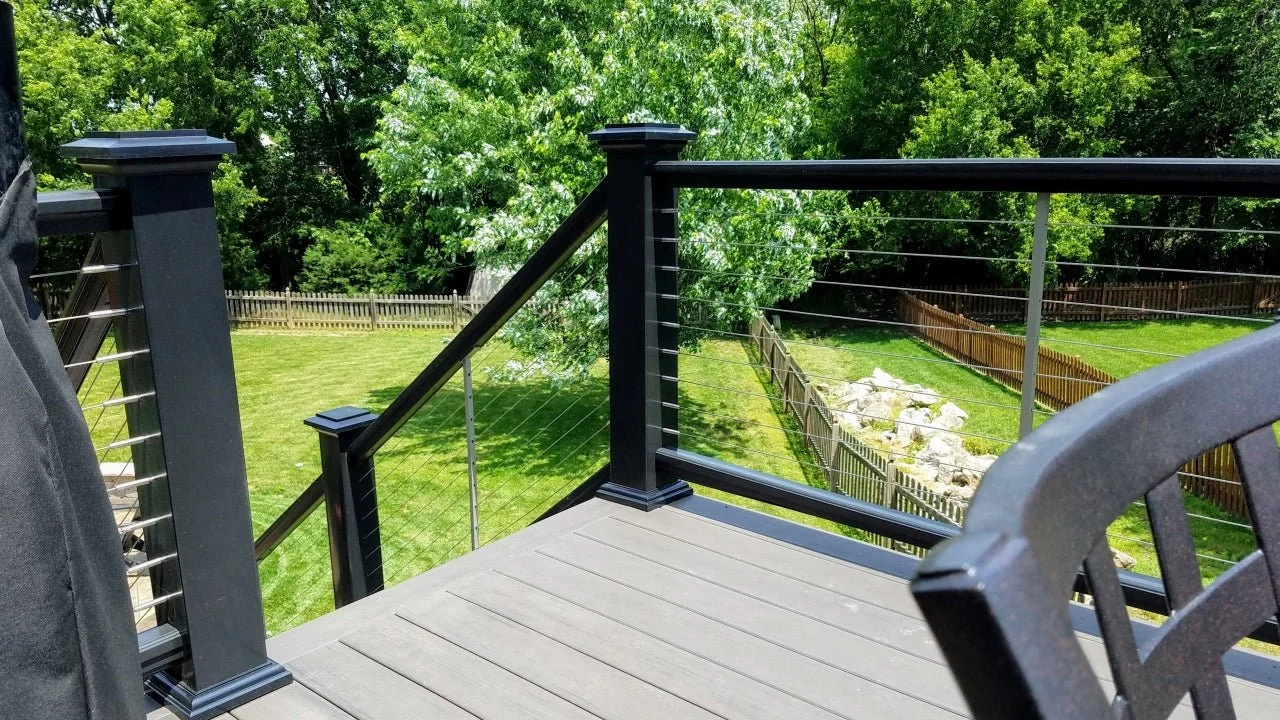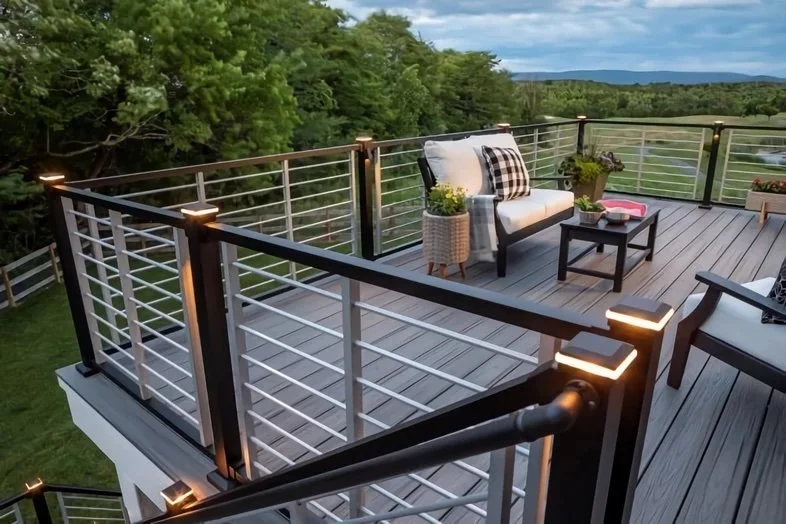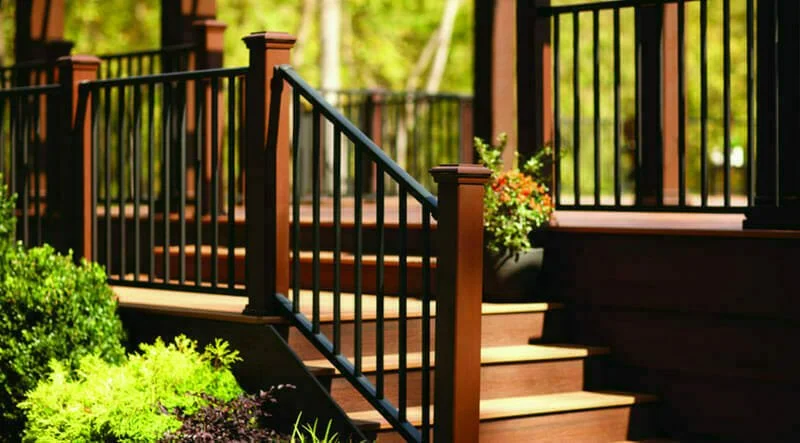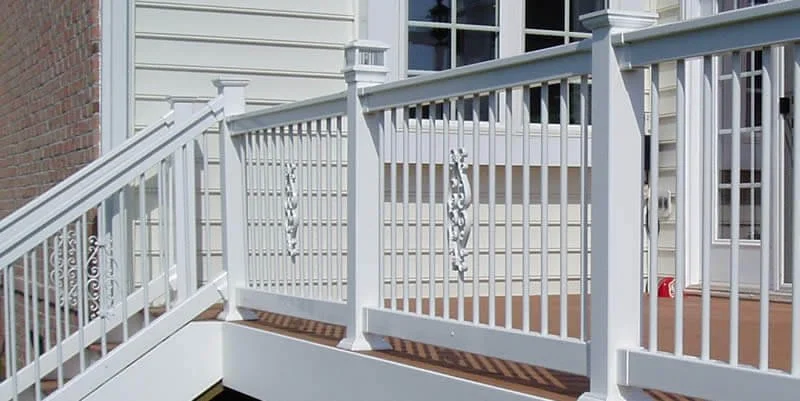8 Deck Railing Options: Discover the Best fit for your deck
Image Source: AI Generated
The right railing defines your deck's character and overall appeal. Your outdoor space deserves careful thought, especially with numerous deck railing options now accessible to homeowners.
Each railing style tells its own story. Classic wood exudes warmth, while modern glass panels create an unobstructed view. Sleek cable wire offers contemporary appeal, and low-maintenance composite materials promise lasting durability. These choices shape your deck's look and determine its safety, upkeep needs, and value over time.
This complete guide walks you through eight distinct railing styles for new builds and upgrades alike. You'll learn about costs, durability, installation details, and maintenance requirements. Our insights will help you pick a railing that matches your home's character and fits your daily life.
Glass Panel Railing Systems
Image Source: Fab Glass and Mirror
Glass panel systems lead the way among modern deck railing options as the perfect example of contemporary design. These sophisticated barriers blend safety and style seamlessly, and homeowners love them because they protect without blocking their beautiful views.
Glass Panel Railing Features
Your deck transforms into an elegant outdoor space with sleek, contemporary glass panel railings. The panels use tempered glass that proves four to five times stronger than regular glass, which delivers exceptional durability and safety. You can choose between clear glass or low-iron glass panels, though low-iron panels cost 20-30% more but provide better clarity.
Glass railings stand out because they offer:
Panoramic views without obstruction
Superior safety through tempered or laminated construction
Protection against weather damage
Sleek, modern looks
Easy integration with LED lighting systems
Glass Panel Railing Cost and Installation
Glass railings deliver premium quality that matches their price point. A complete installation ranges between $500 and $850 per linear foot. A typical 10-foot glass railing project costs between $10,000 and $17,000, which includes materials and professional installation.
Professional installers use two main mounting methods:
Dry glazing: The system uses clamps and rubber gaskets
Wet glazing: The process needs sealants and adhesives (costs 25-50% more)
Glass Panel Railing Maintenance
Glass railing systems need simple but regular care. Regular cleaning with soap and water or standard glass cleaner keeps your panels spotless. Outdoor railings might need more frequent attention, especially after storms that leave water spots.
Your maintenance routine should include:
Regular panel cleaning every few days stops fingerprints from building up
Microfiber cloth use gives you streak-free results
Glass stays safe when you avoid abrasive cleaners
An extendable squeegee helps reach difficult spots
These railings resist environmental damage naturally. They won't rot, corrode, stain, fade, or rust. Good care helps these systems stay beautiful for years, and manufacturers back them with warranties from 10 to 25 years.
Cable Wire Railing
Image Source: HomeGuide
Cable wire railing systems have become a top choice for homeowners who want their decks to look modern and last long deck railing options. These systems pair sleek horizontal cables with strong posts. You get a contemporary look that maximizes your view and keeps everyone safe.
Cable Railing Design Options
You can customize your cable railing system to complement your home's architecture through different material combinations. Horizontal stainless steel cables define these systems. They create a nearly invisible barrier without compromising structural strength.
Key design features include:
Unobstructed panoramic views
Sleek, modern esthetic
Customizable post materials
Weather-resistant components
Minimal visual interference
Cable Railing Installation Requirements
Your cable railing installation needs careful attention to structural requirements. The posts need spacing no more than 4 feet apart on center to maintain proper tension and safety. Wood post systems need a structural post every 8 feet. You'll place intermediate posts every 4 feet between them.
The system needs proper tensioning to stay strong and look good. Standard heights come in either 36 inches with 10 horizontal cable runs or 42 inches with 12 horizontal cable runs.
Cable Railing Price Points
The cost of your cable railing system depends on your material and design choices. A complete system costs between $40 and $180 per linear foot. Here's what different materials cost:
| Material Type | Cost Per Linear Foot |
|---|---|
| Wood Posts | $40-$50 |
| Aluminum | $85-$90 |
| Stainless Steel | $170-$180 |
Your choice of material affects the long-term value. Wood costs less upfront. Aluminum and stainless steel resist weather better and need less maintenance. Coastal homes need corrosion-resistant materials, though they cost more initially.
A complete cable railing system with posts, handrail, cable, and hardware typically costs between $150 and $285 per linear foot. This investment gives your deck a modern look that boosts its appearance while keeping it safe and durable.
Aluminum Deck Railing
Image Source: Deck & Rail Supply
Want the perfect mix of durability and style? Aluminum deck railing stands out as the top pick for homeowners who need a lasting, easy-care solution for their outdoor spaces.
Aluminum Railing Styles
You can customize your aluminum railing to fit any architectural style. The powder-coated finishes give you plenty of designs, colors, and styles to improve your home's look. Aluminum railings offer amazing design flexibility - you can pick anything from traditional balusters to sleek glass infills.
Key style features include:
Pre-assembled sections for clean looks
Multiple color options
Various baluster designs
Decorative post caps and lighting options
Drink rail adaptations for added functionality
Aluminum Railing Durability
Aluminum beats other materials hands down in the durability department. A properly powder-coated aluminum railing lasts 20 years or more. The material naturally fights off corrosion and rust because it's a non-ferrous metal - perfect for any climate. The powder-coated finish stands strong against:
Weather elements
Chemical exposure
UV radiation
Temperature fluctuations
Aluminum Railing Cost Analysis
The price of your aluminum railing depends on several factors. Here's a clear cost breakdown:
| Installation Type | Cost Per Linear Foot |
|---|---|
| Professional Installation | $55-$135 |
| DIY Installation | $55 average |
| Material Only | $48-$95 |
The upfront cost might be higher than other options, but aluminum railing pays off through:
Minimal maintenance requirements
Longer life than wood or vinyl
Less frequent replacement needs
Lower upkeep costs
A typical 50-linear-foot project with professional installation runs between $2,750 and $6,750. This covers all materials, labor, and needed permits. DIY installation saves you substantially on labor costs. The pre-assembled sections and straightforward installation process help you achieve professional results.
The easy maintenance adds to its value. Just soap and water keep your railing looking great. Wood needs regular staining and sealing, and vinyl gets brittle as time passes. Your aluminum railing stays beautiful with minimal effort.
Composite Deck Railing
Image Source: Costimates.com
Change your outdoor living space with the blend of durability and style that composite deck railing brings. This modern railing solution pairs wood's timeless appeal with advanced technology to deliver exceptional deck performance.
Composite Railing Materials
The composite railing system blends wood fibers and plastic materials. This combination creates a product that works better than traditional options. These materials resist rot, mold, and mildew remarkably well. The product uses recycled materials, which makes it an eco-friendly choice for your deck.
These materials give you several advantages:
Weather resistance that lasts
Better protection against UV radiation
Less maintenance needed
Many color choices
Protection from rot and insects
Composite Railing Installation Process
Your composite railing system needs careful planning and attention to detail. Start by making sure your 4x4 pressure-treated posts stand perfectly straight and plumb. The system has post sleeves, horizontal rails, and balusters that fit together without gaps.
Follow these steps for installation:
Mount support posts and ensure proper alignment
Install post sleeves and decorative skirts
Attach top and bottom rails
Insert balusters and secure components
Add final touches like post caps
Composite Railing Pricing
Composite railing costs more upfront but proves its worth over time. The reduced maintenance needs and longer lifespan save money in the long run.
| Component | Price Range |
|---|---|
| Simple Materials | $48-95/linear foot |
| Premium Options | $85-150/linear foot |
| Installation | $25-45/linear foot |
The benefits go beyond the upfront cost. Your railing system can last up to 30 years and needs only soap and water to stay clean. Manufacturers back their products with solid warranties. Standard coverage runs 6-10 years, while premium options might give you 25 years of protection.
Design Flexibility: Your composite railing system lets you customize extensively. Standard manufacturers offer 6-10 color choices, and some give you up to 12 different options to match your home's style perfectly. The system works with built-in features like wire channels and lighting options to create your ideal outdoor space.
Traditional Wood Railing
Image Source: Deck & Rail Supply
Wood stands out as a timeless choice among deck railing options. It brings natural warmth and classic appeal to your outdoor space. Wood's traditional character makes it versatile in design while staying friendly to your budget.
Wood Railing Design Options
You can showcase many styles in your wood railing, from classic pickets to intricate craftsman designs. Wood's beauty shines through its potential for customization - you can pick from pressure-treated pine, cedar, or premium exotic woods that match your vision. The craftsman style really catches the eye with its expertly carved patterns and beautiful grain that adds character to your deck.
Design possibilities include:
Continuous 2x6 cap rails for a clean look
Vertical 2x2 pickets with top and bottom rails
Decorative patterns like diamond or cross designs
Built-in bench options for added functionality
Wood Railing Maintenance Needs
Wood's natural beauty needs consistent care to keep its appeal and structural integrity strong. Your maintenance routine should happen yearly with a deep clean, ideally in spring's mild temperatures. Regular checks help you spot problems early:
Look for signs of rot or structural weakness
Switch out raised nails with wood screws
Fill holes with exterior wood filler
Fix rusted hardware right away
Wood Railing Cost Considerations
The money you'll spend on wood railing changes based on materials and how you install it. Here's a clear cost breakdown:
| Installation Type | Cost per Linear Foot |
|---|---|
| Professional Installation | $26-60 |
| DIY Installation | $14 average |
| Premium Woods | Up to $45 |
Your total cost depends on several key factors:
Wood type and quality - pressure-treated pine costs least
Post and baluster height (36" or 42" options)
Deck's complexity and design features
Extra elements like gates or lighting
Professional installation runs about $34.50 per linear foot. This price gets you proper structural support and expert craftsmanship. DIY projects can save you money if you have carpentry skills, but you must pay close attention to safety requirements.
Cedar and pressure-treated pine remain popular choices. Cedar naturally resists weather damage while pine gives you affordability with proper treatment. Wood needs more upkeep than modern materials, but its lower upfront cost makes sense for many homeowners. You can also repair or refinish it easily over time.
Vinyl Deck Railing
Image Source: Decks.com
Find the perfect mix of toughness and style with vinyl deck railing. This modern solution has changed how we design outdoor spaces. The material lasts long and needs little maintenance, which makes it a top pick for homeowners who want a hassle-free deck.
Vinyl Railing Styles
Your vinyl railing can match many architectural styles and looks great on colonial-style homes. The look features clean lines and glossy finishes that make spaces feel welcoming. The system has:
T-shaped or drink rail top options
Round, square, or ornate turned balusters
Decorative post caps and sleeves
Colonial-inspired design elements
The color choices might be fewer than other materials, but vinyl railings keep their good looks for years. A glossy finish adds elegance that works well with northeastern and southern architectural styles.
Vinyl Railing Durability
Vinyl proves to be one of the toughest materials against weather. Your vinyl railing system protects against many environmental challenges:
Weather Resistance: These railings can handle tough conditions, from strong UV rays to big temperature swings. They stand out because they're:
Resistant to moisture and decay
Safe from insect damage
Protected against UV fading
Strong enough to resist impacts
Most systems come with an aluminum core that connects metal-to-metal brackets. This makes the structure much stronger. The mix of materials helps your railing stay strong and beautiful for decades.
Vinyl Railing Price Range
Vinyl railing gives you great value over time. Here's what it costs:
| Installation Type | Cost per Linear Foot |
|---|---|
| Basic Materials | $23-45 |
| Professional Installation | $25-60 |
| Premium Systems | Up to $85 |
You'll save money on upkeep since all you need is soap and water or a pressure washer to clean it. Wood railings need regular staining and sealing, but your vinyl railing stays looking good with minimal work.
Vinyl's toughness means better value over time, and many makers offer warranties for 20 years or more. The upfront cost might be higher than some other options, but it's budget-friendly when you think about how long it lasts and how little care it needs.
The best systems come with noise-reduction technology that gets rid of that "ping" sound you often hear with vinyl railings. This small detail helps keep your outdoor space peaceful through the years.
Metal Deck Railing
Image Source: DeckSource
Lift your outdoor space with the lasting strength of metal deck railings, a premium choice that combines strong security with sophisticated design. Metal railings are evidence of modern engineering and offer unmatched durability while keeping their esthetic appeal.
Metal Railing Design Choices
Your metal railing system can revolutionize from classic to contemporary with different design elements. Steel railings create a slim profile that allows unobstructed views and look striking in bronze or black finishes. You have options beyond simple styles, including:
Pre-welded, fully assembled panels for clean lines
Decorative post caps and lighting integration
Custom powder-coated finishes
Modern or traditional baluster designs
Metal Railing Durability
Metal railings excel in strength and resilience. Steel emerges as the strongest among metal options and offers superior resistance to denting and damage from normal use. Your metal railing system provides:
Weather Resistance: Metal railings withstand harsh conditions, though location matters during installation. Placement should be at least two miles from saltwater in coastal areas to prevent corrosion. This durability shows in impressive warranty coverage, as many manufacturers offer 15-year limited warranties.
Maintenance Simplicity: Your metal railing needs minimal upkeep. A quick wash with a garden hose or gentle cleaning solution keeps its appearance fresh. Many systems feature multi-layered coatings that combine pre-galvanized steel, zinc, and phosphate premium powder coating for extra protection.
Metal Railing Cost Analysis
Metal railing costs vary by material choice and style. Here's a detailed breakdown:
| Material Type | Cost per Linear Foot |
|---|---|
| Aluminum | $40-$70 |
| Stainless Steel | $30-$80 |
| Wrought Iron | $50-$120 |
Professional installation adds about $30 per linear foot. These additional cost factors matter:
Posts: $20-$115 each
Top and bottom rails: $4-$25 per foot each
Labor: $60-$200 per hour
Permit fees: $20-$30
The investment brings long-term value through virtually maintenance-free performance. Premium systems like Fortress Railing's Fe26 Iron line include advanced coating processes that resist rust and corrosion. Their Al13 Aluminum series offers 100% recyclable materials with a limited lifetime warranty.
Powder-coated finishes maintain their color under UV light exposure. These systems arrive pre-welded and fully assembled, which reduces installation time and ensures professional-quality results.
Mixed Material Railing
Image Source: Costimates.com
Let loose your creativity and combine different materials in your deck railing design. Mixed material railings give you a chance to build a unique outdoor space. This approach shows your personal style and makes the most of each component's benefits.
Mixed Material Design Options
Your mixed material railing system can mix elements from materials of all types to strike the perfect balance of form and function. TimberTech's railing systems show this versatility with six distinct options that help you blend different materials naturally. The most popular combinations include:
Composite top rails with aluminum balusters
Glass panels with metal frames
Cable infills with composite posts
Wood caps with metal structural elements
Premium Combinations: A drink rail with Traditional Walnut paired with Cable Rail infill builds an elegant, see-through barrier. This works especially well with darker deck boards. A more traditional look comes from the Classic Composite Series. You might want white rails with contrasting black square aluminum balusters.
Mixed Material Installation Process
Your mixed material railing needs careful planning and attention to detail. The first step is picking compatible components. Many railing systems work together and give you countless ways to mix and match.
Here's what you need to think about during installation:
How different materials connect structurally
Weather resistance where materials join
Right spacing for different infill types
Hardware that works together
The installation follows a clear order that starts with the strongest parts. When you mix wood and metal, metal structural elements go in first. Then come the wooden decorative pieces.
Mixed Material Pricing
Mixed material railing costs change based on your chosen combinations. Here's a detailed price breakdown:
| Material Combination | Price Range (per linear foot) |
|---|---|
| Composite with Aluminum | $85-$100 |
| Glass with Metal Frame | $120-$150 |
| Cable with Composite | $100-$120 |
| Traditional with Metal | $80-$100 |
Your budget should include more than just materials. These factors affect the final cost:
Premium finishes and coatings
Special hardware needs
Professional installation expertise
Lighting integration options
Design Flexibility: Your mixed material railing can include powder-coated aluminum parts that are both sturdy and stylish. Aluminum elements provide stability throughout and resist moisture and weather damage.
Mixed material railings help you create stunning combinations that improve your outdoor living space. Composite railings work naturally with various infill options, including full glass panels or cable systems. You can find the perfect balance between durability, maintenance, and looks.
Mixed materials do more than just provide a railing - they create a custom outdoor experience that matches your vision and works perfectly. Different materials working together maximize each component's strengths while reducing their limitations.
Comparison Table
| Railing Type | Cost per Linear Foot | Lifespan | Maintenance Requirements | Key Features/Benefits | Installation Complexity |
|---|---|---|---|---|---|
| Glass Panel | $500-$850 | 10-25 year warranty | Regular cleaning with soap/water; frequent cleaning removes fingerprints | Unobstructed views, weather-resistant, modern esthetic | Professional installation needed; complex |
| Cable Wire | $40-$180 | 15-20 years | Minimal maintenance | Unobstructed views, sleek modern look, customizable post materials | Posts needed every 4 feet; proper tensioning essential |
| Aluminum | $55-$135 | 20+ years | Soap and water cleaning | Weather-resistant, fights corrosion, multiple color options | Moderate; pre-assembled sections available |
| Composite | $48-$95 | Up to 30 years | Minimal; soap and water cleaning | Resists rot/mold, extensive color options, UV resistant | Systematic installation process; moderate complexity |
| Traditional Wood | $26-$60 | 20-30 years | Annual deep cleaning, ongoing maintenance, staining/sealing | Natural warmth, highly customizable, repairable | Suitable for DIY; needs carpentry skills |
| Vinyl | $23-$45 | 20+ year warranty | Soap/water cleaning | Weather-resistant, insect-proof, UV-resistant | Moderate; aluminum core support included |
| Metal | $30-$120 | 15+ year warranty | Minimal; wash with hose/cleaning solution | Superior strength, weather-resistant, slim profile | Professional installation recommended |
| Mixed Material | $80-$150 | Varies by material combination | Varies by material combination | Customizable design, combines benefits of different materials | Complex; careful planning required |
Conclusion
The right deck railing for you depends on your budget, maintenance priorities, and design style. Glass panels create stunning unobstructed views but need frequent cleaning. Cable wire systems blend modern appeal with low maintenance needs. Aluminum and composite materials deliver both durability and style that add value over time.
Traditional wood adds natural warmth at a lower original cost but needs consistent care. Vinyl excels at weather resistance and easy maintenance. Metal railings provide superior strength that lasts. You can mix different materials to create a custom solution that matches your needs perfectly.
These factors will help you make the right choice:
How durable the material is in your local weather
The time you can spend on maintenance
Your budget now versus future costs
How well it matches your home's look
Want to revolutionize your deck with the perfect railing? RMFP has many railing options that pair beautifully with your decking. We'll help you create your dream outdoor space that's safe, stylish, and built to last with the right materials and expert advice.
FAQs
What is the most suitable type of deck railing?
Aluminum railings are highly recommended due to their affordability compared to steel and their resistance to rust unlike iron. Cable and glass railing systems often incorporate aluminum posts and rails to achieve their distinctive styles. Composite railings, on the other hand, tend to have a bulkier appearance and are typically used for more traditional or classic railing profiles.
What is the maximum allowable distance between deck railing posts?
According to the International Building Code (IBC), manufactured deck railing posts should not be spaced more than 8 feet apart.
How should deck railing posts be arranged?
Deck railing posts are usually spaced 6 feet apart on-center, but they should not exceed 8 feet apart on-center. It's important to ensure that the posts are evenly spaced. If a railing post coincides directly above a deck joist, it should be slightly repositioned to avoid structural issues.
Is a handrail necessary for a deck that is 16 inches off the ground?
According to deck railing codes, any deck that is more than 30 inches above the ground must have a guardrail. If a deck is lower than 30 inches, installing a guardrail is optional, but if chosen, it must still comply with code requirements.

